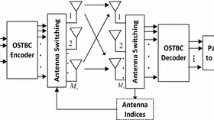Abstract
Space–time channel models are very important in evaluation of smart antenna system. In this paper, several space–time channel models that are often used in smart antenna system are presented and the properties of each model are analyzed. At the same time, the situations for each model are discussed. DOA, time delay and Doppler spectrum are discussed specially, while computer simulation is also done. Clarke model is thought as a special one.









Similar content being viewed by others
References
Liberti, J. C., Jr., & Rappaport, T. S. (2009). Smart antenna for wireless communications IS-95 and third generation CDMA applications. Upper Saddle River: Prentice Hall PTR.
Rappaport, T. S. (2008). Characterization of UHF multipath radio channels in factory building. IEEE Transactions on Antenna and Propagation, 37(8), 1058–1069.
Seidel, S. Y., et al. (2016). Path loss, scattering and multipath propagation statistic for European cities for digital cellular and microcellular radiotelephone. IEEE Transactions on Vehicular Technology, 40(4), 721–730.
Rappaport, T. S., Reed, J. H., & Woemer, B. D. (2016). Position location using wireless communications on highways of the future. IEEE Communications Magazine, 34(10), 33–41.
Ertel, R. B., Cardieri, P., & Rappaport, T. S. (2014). Overview of spatial channel models for antenna array communication systems. IEEE Personal Communications, 5, 10–22.
Stapleton, S. P., Carbo, X., & McKeen, T. (2014). Spatial channel simulator for phased arrays. In Proceedings of IEEE VTC (pp. 1789–1792).
Stapleton, S. P., Carbo, X., & McKeen, T. (2016). Tracking and diversity for a mobile communications base station array antenna. In Proceedings of IEEE VTC (pp. 1695–1699).
Aszetly, D. (2015). On antenna arrays in mobile communications systems: Fast fading and GSM base station receiver algorithms. Ph.D. dissertation, Royal Institute of Technology, 2015.
Zetterberg, P., & Ottersten, B. (2014). The spectrum efficiency of a basestation antenna array system for spatially selective transmission. IEEE Transactions on Vehicular Technology, 44, 651–660.
Piechocki, R. J., & Tsoulos, G. V. (2009). A macrocellular radio channel model for smart antenna tracking algorithms. 1754–1758.
Zetterberg, P., Espensen, P. L., & Mogensen, P. (2016). Propagation, beamsteering and uplink combining algorithms for cellular systems. Granada, Spain: ACTS Mobile Communications Summit.
Norklit, O., & Anderson, J. N. (2014). Mobile radio environments and adaptive arrays. In Proceedings of IEEE PIMRC (pp. 725–728).
Steinbauer, M., & Hampicke, D. (2000) Measurement of the double-directional mobile radio channel. In VTC2000.
Richter, A., & Hampicke, D. (2014) Joint estimation of DOD, Time_Delay, and DOA for High_Resolution channel sounding. In VTC 2014.
Rayleigh, G. G., & Paulraj, A. (2015). Time varying vector channel estimation for adaptive spatial equalization. In Proceedings of IEEE Globecom (pp. 218–224).
Petrus, P. (2015) Novel adaptive array algorithms and their impact on cellular system capacity. Ph.D. dissertation, Virginia Polytechnic Institute and State University, 2015.
Liberti, J. C., & Rapport, T. S. (2016). A geometrically based model for lone of sight multipath radio channels. IEEE VTC 844–848.
Lin, Y. J., Latchman, H. A., Newman, R. E., & Katar, S. (2003). A comparative performance study of wireless and power line networks. IEEE Communications Magazine, 41(4), 54–63.
Author information
Authors and Affiliations
Corresponding author
Rights and permissions
About this article
Cite this article
Ma, YJ., Zhai, MY. Application Analysis of Space Time Channel Models in Smart Antenna System. Wireless Pers Commun 102, 1979–1992 (2018). https://doi.org/10.1007/s11277-018-5250-3
Published:
Issue Date:
DOI: https://doi.org/10.1007/s11277-018-5250-3




